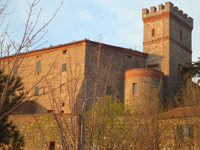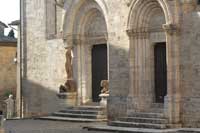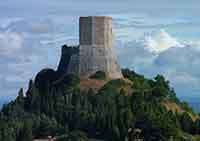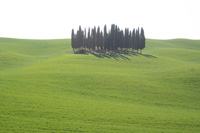Buonconvento |
|||
| Asciano, Castelnuovo Berardenga, Monteroni d'Arbia, Rapolano Terme, San Giovanni d'Asso, Monterongriffoli, Montelifre, Pava and Chiusure are situated in the surroundings of Buenconvento and are within an hour's drive from Podere Santa Pia, a holiday house in southern Tuscany. The road which leads from Castiglioncello Bandini to Asciano and Buenconvento, passing first through Castello Porrona, Montalcino, the Abbazia di Monte Oliveto Maggiore, is breathtaking. In this particular area of the Siena region, many forts and small hamlets are situated on the sites of ancient Etruscan and Roman settlements, evidence of which can still be seen today The most ancient archaeological finds in this area (cult and divination objects) date back to when these hills were inhabited by the mythical descendants of the Lidi people. Many local place names, such as Porrona, Tergomeno, Calatine, Percenna, Trequanda, Tordovana, Elatora and Cetinali come from their language. Incredibly, the local pronunciation of the letter ‘C’ also reflects the Etruscan pronunciation of the letter. There are many ancient tombs in the area surrounding Montelifré at Belsedere, Porrona and at S.Stefano a Cennano. The necropolis at Poggio Pinci is only a few kilometres away and there is an ancient footpath (which today is part of the Crete Senese Tourist Footpath Network) which starts at Asciano and joins the Via Etrusca that goes from Chiusi to Roselle, to the sea and south to the towns of Sovrana, Sorano and Saturnia.[1] |
|||
Buonconvento is an ancient settlement south of Siena, along the Via Cassia, where the Arbia and Ombrone rivers meet in the heart of the magical hills of the Crete Senesi. The name Buenconvento derives from the Latin bonus conventus, meaning "happy, fortunate community". |
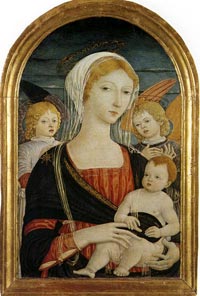 Matteo di Giovanni, Madonna col Bambino e due Angeli, originally in the Chiesa di San Lorenzo a Percenna Matteo di Giovanni, Madonna col Bambino e due Angeli, originally in the Chiesa di San Lorenzo a Percenna |
||
Among the most important monuments to see in Buonconvento we point out here the Parrocchiale di San Pietro, the Oratorio di San Sebastiano, the Palazzo Ricci, hosting today the Holy Art Museum of the valley of Arbia. Comune |
|||
| Buonconvento Restaurants Agriturismo Pieve Sprenna Restaurant Pievesprenna, 53022 Buonconvento, 53022 Buonconvento TNT Pub Pizzeria Localita Bibbiano, 806157 Buonconvento Le Antiche Mura P. Garibaldi 38, Buonconvento Ristorante Da Mario Via Soccini, 60, Buonconvento Osteria la via di mezzo Via Soccini, 53, Buonconvento |
|
||
| San Giovanni d'Asso is located in the heart of the Crete Senesi, characterized by the imposing Medieval castle, home of the Truffle Museum. Worth visiting are the Romanesque church of San Giovanni Battista and, lower down, the church of San Pietro in Villore (11th - 12th century). Over and above the fine stone of San Giovanni, another notable aspect is the environmental heritage of the localities around the Asso valley a decidedly superb landscape. Don't miss the hamlet and castle of Monterongriffoli the rural districts of Vergelle , the poetry of Lucignano d'Asso, Montisi with its historic grange and the extraordinary white road of Pieve a Salti. |
||
| The church of San Pietro in Villore in San Giovanni d’Asso. has only one nave with semi-circular apse and covering with cross vaults, held up by a transversal arch on semi pilasters. Fruit of a restoration of the XX century is the ribbed belltower. The crypt is divided into 4 small naves of three spans. The front has its superior part in fired-brick, surrounded by a recurrence of bricks disposed as teeth a sow, held up by small corbels. The inferior part is scanned by five small arches; in the central one, wider, is kept the portal in the lunette of which is put a sculptural fragment of the High Middle Age. The small capital of the semi-columns which held up the arches are decorated with geometrical and anthropomorphic motives. Also the apse shows a very rich plastic decoration.
|
||
| San Giovanni d'Asso | Il Bosco della Ragnaia
|
||
| The road from Montalcino to Radicofani runs through San Giovanni d’Asso, a small hamlet nestled comfortably in the hills of this beautiful landscape. The ancient romanesque church of San Giovanni Battista is near to the castle, while in the lower part of the village lies the most important church in the area, the beautiful San Pietro in Villore, built in the 11th and 12th centuries, and which is now surrounded by many cypresses. Among the numerous celebrations periodically taking place in San Giovanni d'Asso we remind the Exhibit of the White Truffle held yearly on November, during which it is possible to admire the famous typical white truffles. Il Bosco della Ragnaia on the outskirts of San Giovanni d’Asso, is a modern garden created by artist and philosopher Sheppard Craige that includes elements of formal spaces, modern art, and wooded areas (boschi). Links | Images
|
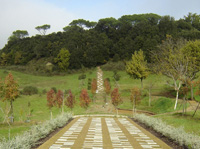 San Giovanni d'Asso | Il Bosco della Ragnaia |
|
Within the municipal territory of Buonconvento rises the picturesque village of Montisi, with its Chiesa dell'Annunziata, its historical grain tower and the extraordinary dirt road of Pieve a Salti. Here, every year, on the Sunday nearest the 5th of August (the festival of the Madonna delle Nevi, the patron saint of Montisi) the joust Giostra di Simone is held. |
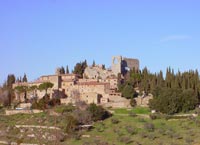 Montelifré |
|
| Montelifre Castle is also important, while at Pava the historical parish church is significant. Montelifré, situated on the top of a gently sloping Sienese hill which is itself dominated by the ruins of a castle dating back to the year 1000, rises along the SS38 between Trequanda and Montisi. Montelifré can be reached from Sinalunga traveling throughout the SS38 toward S.Giovanni d' Asso/Torrenieri or from Siena throughout the scenographic route going along Asciano and San Giovanni d'Asso. During the Medieval period Monteranfredi became a castle, although it was destroyed and rebuilt many times. The fortress was very similar to the fortress at Montalcino which can be seen in the distance. The castle, a great construction in stone having a triangular shape equipped with high and thick walls, dates back to the 13th century. The entire estate was bought by the Tolomeis (a merchant family from Siena) in 1328. This family suffered great losses when their bank went under in 1348 and they sold the estate and all their belongings after the terrible black death to Betto di Martinozzo, a merchant from Montepulciano. The castle’s history reflects that of the Martinozzo family who were first connected to the Medici and then to the Lorena family. The hamlet and its surrounding woods still belongs to the same family. They have turned it into an Azienda Agrituristica (an Agricultural Tourist Business) and it’s possible to visit the San Biagio Church, the fortress, a twelfth/thirteenth century tower and the villa, On the opposite side developed the small village Montelifre, enclosed by town walls gifted with two gates. The whole complex, castle and village, is now a private property, and visible only from the road. |
||
| Pava in the Valley of the Asso is surely one of the oldest and most important transit places which pilgrims used in the Etruscan-Roman period. The Pieve di Santa Maria a Pava dates back to the 4th century. Over the centuries, it was repeatedly destroyed and rebuilt, due mostly to the fact that the Val d'Asso and the Val d'Orcia were part of the great struggle between Siena and Florence. From the original structure, there remains a remarkable piece of rock, which can be seen on the outside of the lateral wall of the church. Behind the church, one can still see a more or less circular foundation of the apse of a later version of the church. The portal is enriched with a fresco, from the early 14th century, representing the 'Madonna with holy child and two saints'. The Pieve di Santa Maria a Pava was one of the nineteen parishes which were contended in the Middle Ages between the dioceses of Siena and Arezzo. The front to which we enter by means of a small stairway, leaned against the ancient parsonage is very simple, in travertine ashlars and bricks. The archivolt portal, without a plastic decoration is enriched with a fragmentary frescoed lunette maybe of the XIV century, representing the Madonna with Christ Child and two Saints. The lateral face of the building is in travertine ashlars. Recovered after decades of abandon, it is nowadays a private property. |
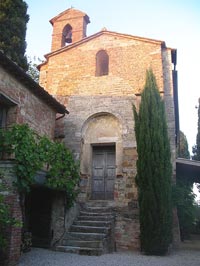 Pieve di Santa Maria in Pava |
|
| Monterongriffoli is a semi-inhabited medieval hamlet a few kilometers down the road from San Giovanni d' Asso near Montalcino, hidden behind the church, with no signposts and only a small carved stone plaque to identify it. |
||
Buonconvento |
||
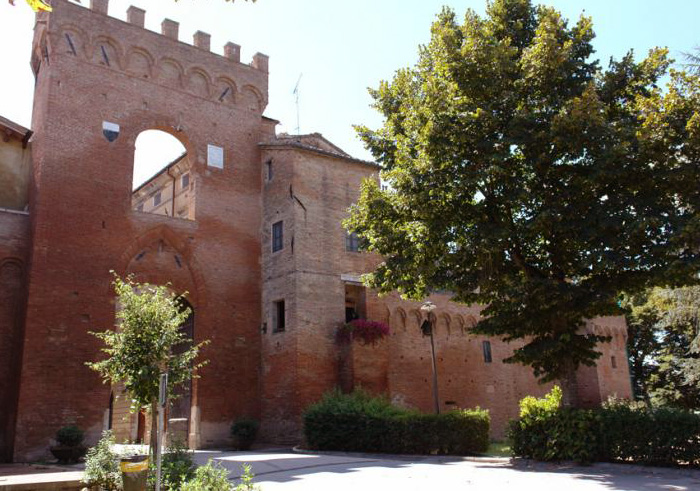 |
||
Buenconvento, gate
|
||
Monteroni d'Arbia is an agricultural center, crossed by the Via Francigena, 17 km southeast of Siena. |
|
|
| The Pieve di San Giovanni Battista, at Corsano, dates from before 1031. With a nave and two aisles, it is an example of Romanesque architecture with Pisan and Lombard influences. It houses two canvasses by Alessandro Casolari. |
||
| The church of Sts. James and Chrstopher, at Cuna, has remains of 14th century frescoes. On the road linking Siena and Monteroni another important point for the traveller seeking the genius loci of the Crete is the monumental farm of Cuna, an extraordinary fortified grancia hat was part of Santa Maria della Scala . The splendid massive structure of Grancia di Cuna is a beautiful example of a medieval fortified grain tower (13th century), originally belonging to the Hospital of Santa Maria della Scala which used it as a massive container for grain. The word grancia, or grange of French derivation, denotes a building with the functions of storehouse and granary. In the middle ages granges were rural buildings situated on the estate of an abbey for the storage of agricultural produce. Initially the Sienese granges had both of these features. They came under the Spedale di S. Maria della Scala of Siena and consisted of buildings for storing the harvests of an extensive property. But in Siena the granges had an additional specific element: they were equipped with considerable fortified structures. They were built, in a word, not only to preserve agricultural produce but also and above all to defend it against military threats. The defensive apparatus consisted of three basic elements, though they are not visible everywhere today: walls, towers and granaries. A wall, the main defensive element, surrounded and protected the buildings. The plan was essentially quadrilateral and adapted to the local morphology. |
||
| Taking the Cassia in the direction of Buonconvento you soon come to Lucignano d’Arbia, a fortified village where the Romanesque parish church of San Giovanni Battista frescoed in the 6th century by Arcangelo Salimbeni is well worth a visit. Setting out once more from the Cassia, the road leading to Radi follows another splendid stretch of the Crete and arrives at the magnificent Corsano parish church. |
||
| Castelnuovo Tancredi. The ancient castle is composed of a tower dating back to the eleventh century, and the later added Medicean style villa in the sixteenth century. Still later a church was constructed adjacent to the main villa, which was dedicated to the Saint Bartolomeo. On the main altar Lorenzetti dedicated a marvelous painting to the Madonna and her Child which can be admired today in the Buonconvento museum of Sacred Art. The estate has 8 hectares of specialized vineyards. [1] | 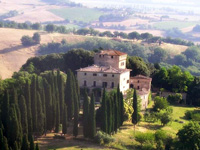 Castelnuovo Tancredi Castelnuovo Tancredi |
|
| Chiusure on the top of which survived the rearranged rests of an ancient castle which is part of Saint Angelo in Luco. It is situated on a high slope which, in the past, was covered with woods, where the Monastery of Monte Oliveto Maggiore was erected, into the village of Chiusure, about 1 km far. The antiquity of this settlement is testified by the fact that its church of Saint Angelo in Luco, at the beginning of the VIII century, was the object of a dispute among the bishops of Siena and those of Arezzo. It is also mentioned in the approval bill of the Congregation of the Olivetans, and of their major monastery, where it is said that it was founded in the district of Saint Michele in Luco’s parish. From some ancient sienese memoirs, we know that Antonio di Meo Tolomei bought Chiusure in 1333. It seems superfluous to add that the founder of the Congregation of Monte Oliveto belonged to the same sienese family of Tolomei and that the hillock of Acona, where the first hermitage was erected, was wooded. | ||
| The fortified settlement of Bibbiano, commanding from a hill the Ombrone Valley and the underlying town of Buonconvento, dates back to the year 850. Bibbiano castle is made up of two structures, the keep and the double walled enclosure surrounded by the ditch, running on three of the four sides. The unique gatehouse is finely framed with sandstone ashlars and protected by a great number of arrowslits and loopholes. Facing the inner curtain is still visible the wall walk. The complex is, mainly for its still intact medieval aspect, one of most remarkable of the whole Sienese countryside. Today is private property visible only from the outside. | ||
| The actual fortified village of Murlo, consisting of the imposing bishop's palace and its courtyard, has been expertly restored and is now centred on the magnificient Antiquarium, where the archaeological finds from the greatly significant site of Poggio Civitate are gathered. Palazzo Vescovile was erected on the site of an pre-existing Abbey first Benedettina then Camaldolese. The Duomo is dedicated to S. Giovanno Evangelista. Initially it was the Abbey Church, enlarged and modified from 1300 in the subsequent centuries until the radical intervention of 1936-1945. The interior has three naves on columns and of Roman structure with Gothic influences, and hosts exquisite works of art. Nearby are the ruins of Crevole Castle, whose cleft tower rises up blade-like from the dark green of the holm oaks to cut sharply into the sky. Near Murlo, Poggio Civitate is the excavation site of an Etruscan patrician residence in the sixth and seventh centuries BC. Largely intact at the time of its unearthing, its architectural detailing illuminates elements of both the Etruscan Orientalizing Period and the Archaic. Weekly market in Murlo (Casciano di Murlo) is on Thursday 8:00-13:00. |
||
| Near Murlo is Vescovado Di Murlo, an important centre that was formed by joining the villages Andica and Tinoni which were still separate at the beginning of the 19th century. In Vescovado the parish church of San Fortunato retains the large altarpiece in the form of a triptych by Benvenuto di Giovanni signed and dated 1475 representing the Madonna enthroned with Child, musician angels and Saints Catherine, Archangel Michael, Blaise and Lucy and above the Benedictory Christ and the Saints Ansano and Lawrence. This is a work of great formal elegance in which the consideration of the new ideas about perspective, derived from Vecchietta is here quite evident. In the same church there is also the only surviving panel of a missing polyptych by Andrea di Niccolò painted for the parish church of Carli, the Madonna and Child, central panel of a triptych whose side panels representing the Saints are in museums abroad. In Ancaiano, Guidoccio Cozzarelli had painted an altarpiece with a similar subject (The Madonna and Child with the Saints Sebastian, Bernardino and two Angels), dated 1491. Weekly market in Vescovado di Murlo is Fortnightly on Monday. |
||
| The comune Trequanda comprises the three villages of Trequanda, Petroio and Castelmuzio. Petroio (13th century) is built on a curious circular plan and is one of the best brick castles in the region. A few kilometres to the northeast is the Abbadia a Sicile, a beautiful Italian old village. TTrequanda, a slighter larger village also preserves a good section of its castle. The Romanesque parish Chiesa dei SS. Pietro e Andrea has a brown-and-white chequered stone facade. Inside is a fresco of the Trasfiguration by Sodoma and a triptych by Giovanni di Paolo with Madonna and Child. | 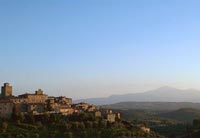 Petroio |
|
Casa Santa Pia is a holiday house in southern Tuscany. Buonconvento, Castelnuovo Berardenga, Monteroni d'Arbia, Rapolano Terme, San Giovanni d'Asso, Siena, Sinalunga and Trequanda are situated in the surroundings of Asciano and are within an hour's drive from Podere Santa Pia. The road which leads from Castiglioncello Bandini to Asciano and Buenconvento, passing first through Castello Porrona, Montalcino and the Abbazia di Monte Oliveto Maggiore, is breathtaking. Arbia, Chiusure, Castelnuovo Scalo en Torre a Castello are frazioni of Asciano. Distances from Podere Santa Pia | Buonconvento 46 km | San Giovanni d'Asso 51 km| Trequanda 62 km | Asciano 64 km | Montalcino 34 km |
||
Enlarge map |
||
[1] The Crete Senesi refers to an area of the Italian region of Tuscany to the south of Siena. It consists of a range of hills and woods among villages and includes the comuni of Asciano, Buonconvento, Monteroni d'Arbia, Rapolano Terme and San Giovanni d'Asso, all within the province of Siena. Crete senesi are literally ‘Siennese clays’ and the distinctive grey colouration of the soil gives the landscape an appearance often described as lunar. This characteristic clay, known as mattaione, represents the sediments of the Pliocene sea which covered the area between 2.5 and 4.5 million years ago. In the nearby is also the semi-arid area known as Accona Desert. The area suffered extreme depopulation due to plagues in the Middle Ages, and the attendant prolonged lack of cultivation facilitated an almost complete erosion of the topsoil. It was later settled by Sicilian farmers adept to cultivating cereals on less than optimal conditions, and who were able to establish sustainable cultivation of wheat on the Siennese clays. Tuscany | Le Crete Senesi |
||
| Museo d'Arte Sacra della Val d'Arbia |
||
| Inaugurated in 1979 into another expositive context, the Museum has been moved into the Palace Ricci Solini, a delicious example of architecture and internal decoration in Liberty style. It was a parish priest from Buonconvento, don Crescenzio Massari, who, in 1926, collected all the works of art and created Museum of Sacred Art of Val d’Arbia, which is richer and more complete than the first one, but with the same purposes of the starting collection: to document the worship and the artistic expression of the valley’s devotion. The collection consists in sacred art-works (paintings, sculptures, textile goldsmitheries) of the territory of Val d’Arbia, to testify the sienese culture from the XIII to the XIX century, with its main protagonists: Duccio, Pietro Lorenzetti, Luca di Tommé, Andrea di Bortolo (XIV century); Sano di Pietro, Matteo di Giovanni, Girolamo di Benvenuto, Pietro di Domenico, Guidoccio Cozzarelli (XV century); the followers of Beccafumi, from Bartolomeo di David to the Brescianino and Riccio (XVI century); Rutilio Manetti, Francesco Vanni, Astolfo Petrazzi, Ventura e Simondio Salimbeni, Francesco Bartolini and Bernardino Mei (XVII century). Very interesting is also the presence of objects used by the laic companies, in particular the so called “stretchers” and the different tabernacles and the small temple created by the main artists of that time. Arbia Valley Museum of Religious Art | Via Soccini, 17 | Opening time: Tues. to Sat. 10-12 and 15-17, Sun. 10-12 (winter). Tues. to Sat. 10-12 and 16-19, Sun. 10-12 (summer) • closed on Monday. |
||
The Sienese Saints of the Fifteenth Century | Buonconvento, Museo d'Arte Sacra of Arbia Valley
|
||
|
||||
Monte Cucco wine region |
Castiglioncello Bandini |
San Qurico d'Orcia |
||
Rocca di Tentennano |
||||
| Montalcino Restaurants |
S.Angelo in Colle Restaurants | |||
|
Castello Banfi La Taverna Re di Macchia Taverna del Grappolo Blu Osteria di Porta al cassero |
Boccon di Vino Ristorante Al Giardino Ristorante Trattoria L'Angolo |
Trattoria Il Pozzo |www.trattoriailpozzo.com S. Angelo in Colle, Piazza del Pozzo Telefono 0577 844015 Nel cuore del borgo medievale di S. Angelo in Colle, dove la Val d'Orcia incontra la Maremma, Franca e Paola Binarelli propongono ogni giorno, in una calorosa atmosfera familiare, i migliori piatti della cucina tipica del territorio. Ristorante Il Leccio | www.trattoriailleccio.it S. Angelo in Colle, Via Costa Castellare Telefono 0577. 844 175 |
||
Podere Santa Pia is located 3 km from Castigliocello Bandini, 15 km from Abazziia San 't Antimo and Montalcino, and 1 hour away from the seaside and close to art cities like Siena, Pienza, Montepulciano and San Quirico d'Orcia. This page uses material from the Wikipedia articles Abbey of Sant'Antimo, Montalcino, published under the GNU Free Documentation License. |
||||
Val d'Arbia's trails | A well marked path system taking you through the unpolluted countryside of the Sienese Crete. Via Lauretana Antica In this area there are some farms about 4 kilometres from Asciano, along the Via Lauretana Antica, being in a raised position as regards to the surrounding valleys. Turning the eyes southwards, you can enjoy a splendid view over the village of Asciano.
|
||||
 |
||||
Nearby the town of Sant’Angelo in Colle, 6km from Sant’Antimo, an enchanting well-preserved village on the top of a hill contained in its circle of walls. You can drive there on a dirt road from Sant’Antimo or on a paved road from Montalcino. |
||||
|
||||
| There is a hiking trial from Sant'Antimo which takes you up into the woods towards Montalcino. The trail is well marked - it goes to your right from the main pathway to the church, just before you turn left to go to the church. Both times we were there we walked out along the trail for about 30 minutes, then walked back, but you can walk all the way to Montalcino. You get some lovely views of the church and the valley along the trail. The Blue Guide also mentions the town of Sant'Angelo in Colle, 6km from Sant'Antimo, as being an "enchanting well-preserved village on the top of a hill ... contained in its circle of walls". You can drive there on a white road (dirt road) from Sant'Antimo or on a paved road from Montalcino. |
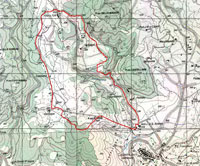 |
|||
| The Via Francigena in provincia di Siena The Via Francigena | From Siena to Ponte d'Arbia | 28,5 km |
||||
Departure: Siena, Piazza del Campo A second itinerary starts in Buonconvento, near the Ponte d'Arbia, and leads to San Quirico d'Orcia, in the heart of the Val d'Oria.
|
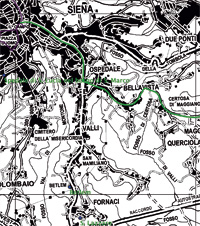 |
|||
| From Buonconvento to Monte Oliveto Maggiore |
||||
Start: Buonconvento . |
||||
 |
 |
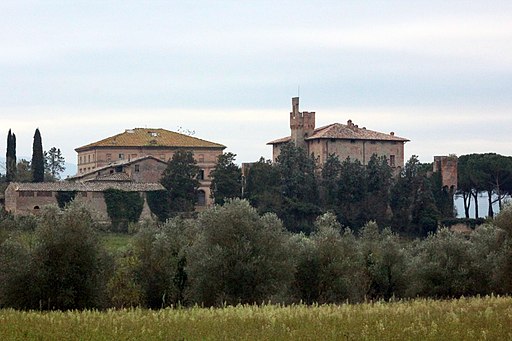 |
||
| Castello Bibbiano, Buonconvento | Castello di Bibbiano, Bibbiano
|
Castello di Bibbiano, Bibbiano | ||
Maps and descriptions available in Podere Santa Pia Kompass map 653 Pienza - Montalcino - Monte Amiata (1:50.000) |
||||
 |
||||
Podere Santa Pia, situated in a particularly scenic valley, which overlooks on the hills around Cinigiano,
up to the Maremma seashore and Monte Christo |
||||
The Maremma is a large area in southern Tuscany. It is a perfect microcosm that stretches between the provinces of Livorno and Grosseto. In the Divine Commedy, Dante Alighieri identified its borders from "Cecina to Corneto" (Tarquinia in Lazio). Maremma is unique because of the variety of its territory: blue sea, long beaches, black rock, hills covered with woods, marshes and flat lands, green hills and natural thermal baths. |
||||
|
||||
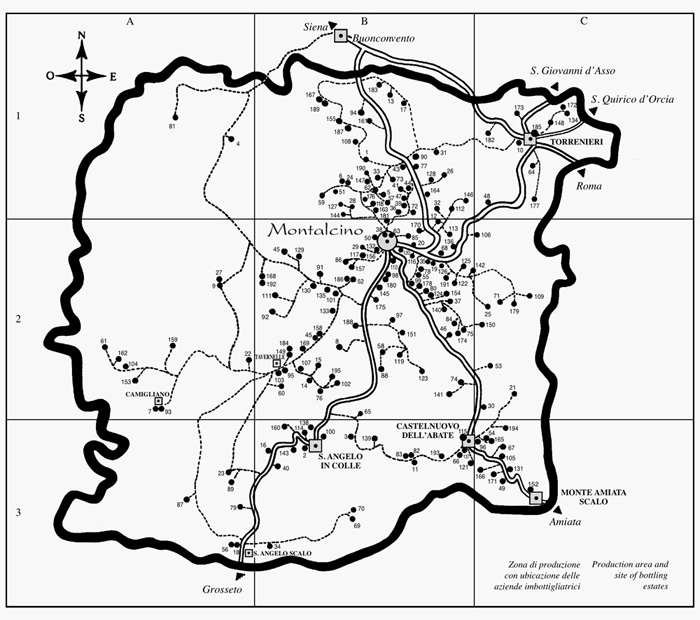 |
||||
| Member companies of the DOCG Brunello di Montalcino [1] |
||||
| A B C D E F G H I J K L M N O P Q R S T U V W Z | ||||
|
||||
| La Strada del Vino Montecucco (The wine road of the Montecucco) Also the wine road of the Montecucco is part of the four Maremman wine roads. It is located in the interior of the Maremma towards the Monte Amiata. Starting from north with Bagno di Petriolo, passing Civitella Marittima until the center of the area with Cinignano. From there it goes towards west, passing the Mountain Montecucco after which is called the wine road, until Campagnatico. The easter part is Monticello, Castel del Piano (Torre dell’Orologio), Seggiano until reaching Ansedonia. La Strada del Vino Nobile di Montepulciano (The wine road of the Vino Nobile di Montepulciano) The area of the Vino Nobile di Montepulciano is situated between the Val d’Orcia (Orcia Valley) and the Val di Chiana (Chiana Valley), borders in the east with Umbria. The road starts in the north with Abbadia towards Montepulciano, passing Cervognano, Acquaviva until S. Albino. Only after two years of storage the wine can be called Vino Nobile di Montepulciano. This wine was the first one classified as DOCG and is one of the most important Italian wine types byond the Italian bounds. Already in the 17th century, Francesco Redi called this wine the king of the Tuscan wine. The Rosso di Montepulciano, classified as DOC-wine is not aged for two years in wood barrels and is intended for the immediate consumption. La Strada del Vino Orcia has its headquarters at the foot of the Fortress to Tentennano of Castiglione d'Orcia. Thirteen municipalities are included in the DOC Orcia Buonconvento, Castiglione d'Orcia, Pienza, Radicofani, San Giovanni d'Asso, San Quirico d'Orcia, Trequanda, Abbadia San Salvatore, Chianciano Terme, Montalcino, San Casciano dei Bagni, Sarteano Torrita di Siena. The common element in the territory on which runs the Wine Route Orcia is the landscape, the most characteristic and charming of Tuscany, perhaps the most beautiful countryside in the world. |
||||
| Strada del Vino Orcia | Castelnuovo Tancredi | Az.Ag. Castelnuovo Tancredi - 53021 Buonconvento - Siena www.castelnuovotancredi.it |
||||
| The Castelnuovo Tancredi farm estate is situated amongst the rolling hills of the Sienese countryside, confining the world renowned territories of Montalcino and Murlo, in the Val d'Orcia. The ancient castle is composed of a tower dating back to the eleventh century, and the later added Medicean style villa in the sixteenth century. Still later a church was constructed adjacent to the main villa, which was dedicated to the Saint Bartolomeo. The Church of San Bartolomeo dates back to the XIII century and had a first restoration in 1336 and another one in 1655. On the altar there was a small oval painting which represents the martyrdom of S. Bartolomeo, which is considered the sketch of the canvas painted by Alessandro Casolani for the church of the Carmine in Siena, which is the late new elaboration of the same subject made by a painting of the half of the XVII century; the work is today exposed on the right wall. In the church there was a Madonna with Christ Child which constituted the central part of the polyptic which was ordered for the main altar after the restoration of 1336. It was rediscovered as a work of Pietro Lorenzetti, under the eighteenth-century repainting which had transformed it in a poor devotion work. The tablet is shown today in the Museum in Buenconvento. The estate Castelnuovo Tancredi has 8 hectares of specialized vineyards which are made up of various grapes and clones such as Sangiovese, Merlot, Cabernet Sauvignon, Syrah, Foglia Tonda, Colorino, Chardonnay and Trebbiano. Wines: Orcia Rosso L'Assedio DOC, Castelnuovo Tancredi Orcia bianco DOC, L'Ambasciatore Rosso IGT. [read more] |
||||
|
||||
Petroio is built on a curious circular plan |
||||

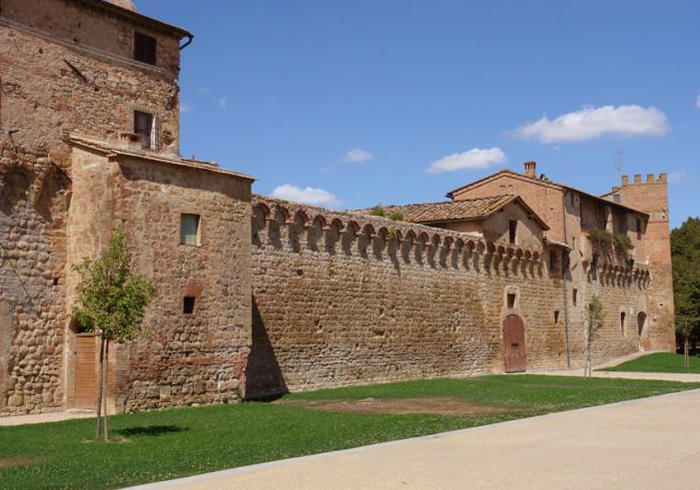
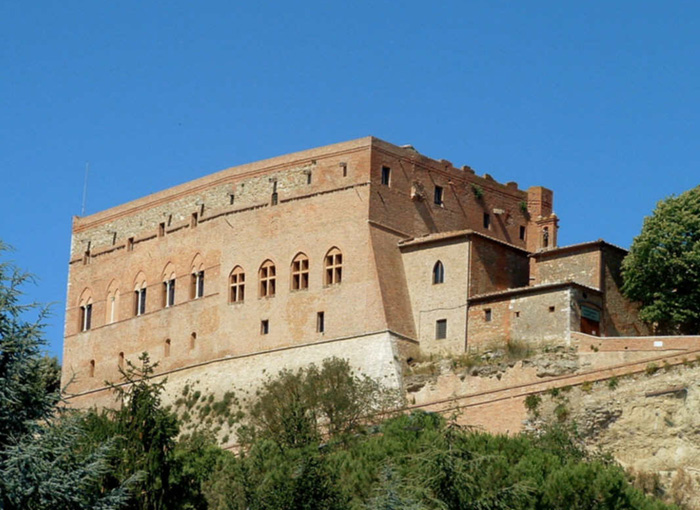
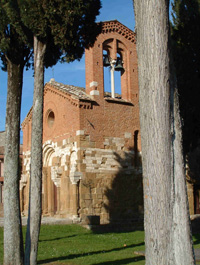
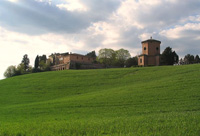 Monteroni d'Arbia
Monteroni d'Arbia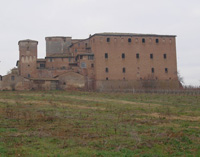 Grancia di Cuna
Grancia di Cuna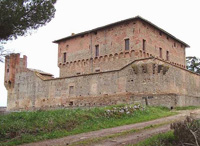 The fortified settlement of Bibbiano
The fortified settlement of Bibbiano



